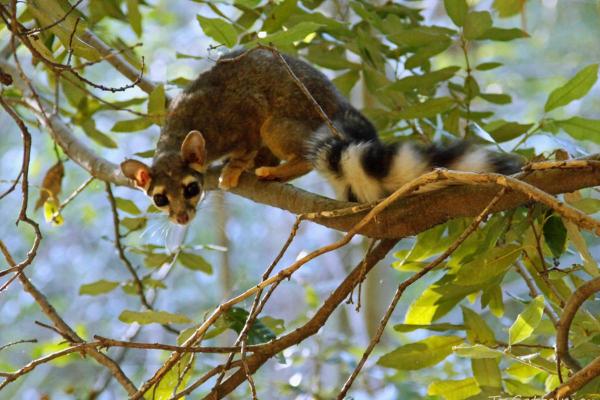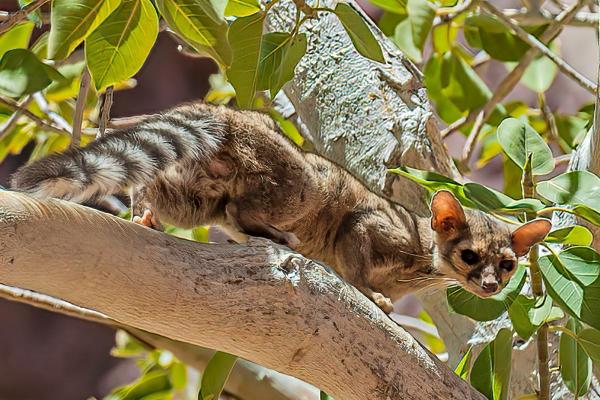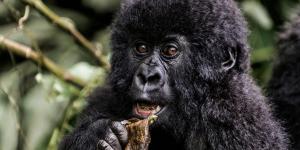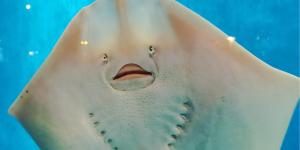What Do Cacomistles Eat?


Cacomistles (Bassariscus sumichrasti) are animals that belong to the Procyonidae family, a family of animals that also contains kinkajous, coatis and the raccoon. This latter animal is the most widely distributed procyonid in the world, but the cacomistle is much less known. This is partly due to its much more limited population distribution, as well as the fact they live in much more secluded habitats. Even if you lived near their Central American habitats, they generally stay away from human settlements. For this reason, we may know little about cacomistle diet, behaviors and other traits.
Cacomistle are part of the genus Bassariscus, of which there are only two species. The other is more commonly known as the ringtail (Bassariscus astutus), but it is also sometimes known as the cacomistle or cacomixtle. Since they are not very well known, you may want to learn more about these endearing arboreal mammals. You can do so with our AnimalWised article whish asks what do cacomistles eat?
Are cacomistles carnivorous or herbivorous?
Cacomistles are classified within the order of carnivorous animals known as Carnivora, specifically in the suborder Caniformia. Caniforms are known as ‘dog-like’ carnivorans, a group that unsurprisingly contains dogs, as well as bears, mustelids and even walruses. They are often juxtaposed with feliforms, meat-eating animals which bear similarities to the felids (i.e. cats).
Since cacomistles are carnivorous, they have certain physical adaptations which allow them to consume animal meat in their diet. These physical traits include the following:
- Carnassial teeth: modified to cut meat, so that its consumption can be much more efficient for animals that depend on this food source. They also have canines to kill prey and tear their flesh for consumption.
- Claws: they are also useful for killing prey, but can be used to hold their food while eating, as well as navigate their environment. For example, cacomistles are arboreal, so they can climb tress to reach prey.
Although contained within the Carnivora order and animal meat is primary in their diet, they are not strict carnivores. Cacomistles are actually omnivores. This is because they also include various types of plant material in their diet.
By eating an omnivorous diet, they have undergone a series of modifications to their teeth, one of the greatest distinctive features of carnivorous animals. This is similar to the rest of the members of the procyonid family. This can be seen in the different types of raccoons, one of the closest procyonids to the cacomistle.
In this way, incisors, canines, premolars and molars are present in cacomistles. However, the carnassial teeth (those which correspond to the upper fourth premolar and lower first molar) are less developed. Since their diet is more generalized, these teeth are adapted to also break down various types of plant matter for consumption.

What do baby cacomistles eat?
Cacomistles are mammalian animals, meaning they feed from the breastmilk of their mother when they are born. The young of this species are known as kits and are born altricial. This means they are unable to fend for themselves. Their eyes have not yet opened, they weigh as little as 25 g and they are totally dependent on their mother. She feeds them exclusively on breastmilk for around 1 month. After this time, she weans them onto solid food.
When the cacomistle kits are about two months old, they leave their original nesting site to accompany their mother in search of food. Doing so helps to teach them the skills they need to survive on their own after their development. They continue eating some breastmilk until they are two and half months of age. After this time, they consume only solid food.
If you want to learn more about this fascinating arboreal mammal, take a look at our article which asks are cacomistles dangerous?
What do adult cacomistles eat?
We have already mentioned that adult cacomixtles have an omnivorous diet . They are also considered generalists since they have a wide range of food, depending on their availability.
With this in mind, we can see some of the main components of the cacomistle diet by looking at what cacomistles eat:
- Mice
- Rabbits
- Squirrels
- Insects
- Birds
- Lizards
- Snakes
- Frogs
- Carrion
- Eggs
- Acorns
- Mistletoe
- Berries
- Wild figs
- Papayas
- Bananas
- Nectar
- Seeds
Learn more about what related procyonids eat with our article on what do raccoons eat?

When and how much does a cacomixtle eat?
As we have stated above, the cacomistle is an animal with mainly arboreal habits. This means it spends the majority of its time in trees. For those that do venture to urban areas, it is also common to see them moving along roofs, ledges and high areas of buildings. This mimics their arboreal behavior in the wild and can pose dangers such as being electrocuted on power lines.
In relation to their eating habits, the cacomistle eats mainly at night. They are types of nocturnal animal and are most active during this period. They spend much of their time searching for food and feeding. After eating, it is common for them to sit on their posterior and groom themselves. They dedicate much time to their hygiene, licking their paws to clean their face, ears and other sensitive areas.
It is not known how much a cacomixtle eats in a day. However, reviews of their feces suggest they consume more or less equal proportions of animal and plant matter. There are minor variations from one individual to the other.
Reviews of cacomistle fecal matter also show that during spring and summer, insects, rodents and berries constitute a large part of their daily diet. The reason for this is simply due to their seasonal availability. As we have mentioned, when having a generalist diet, consumption will depend on availability. This is directly related to the season or time of year.
Discover similar animals to these procyonids with our article on animals that look like raccoons.
If you want to read similar articles to What Do Cacomistles Eat?, we recommend you visit our Facts about the animal kingdom category.
- Goldberg, J. (2003). Bassariscus astutus. Animal Diversity Web. Retrieved from: https://animaldiversity.org/accounts/Bassariscus_astutus/
- Lundrigan, B., & Zachariah, T. (2001). Bassariscus sumichrasti. Animal Diversity Web. Retrieved from: https://animaldiversity.org/accounts/Bassariscus_sumichrasti/
- Pino, J., Samudio Jr, R., González-Maya, J. F., & Schipper, J. (2020). Bassariscus sumichrasti (amended version of the 2016 assessment). IUCN Red List of Threatened Species 2020: e.T2613A166521324. https://dx.doi.org/10.2305/IUCN.UK.2020-1.RLTS.T2613A166521324.en
- Reid, F., Schipper, J., & Timm, R. (2016). Bassariscus astutus. IUCN Red List of Threatened Species 2016: e.T41680A45215881.https://dx.doi.org/10.2305/IUCN.UK.2016-1.RLTS.T41680A45215881.en.







